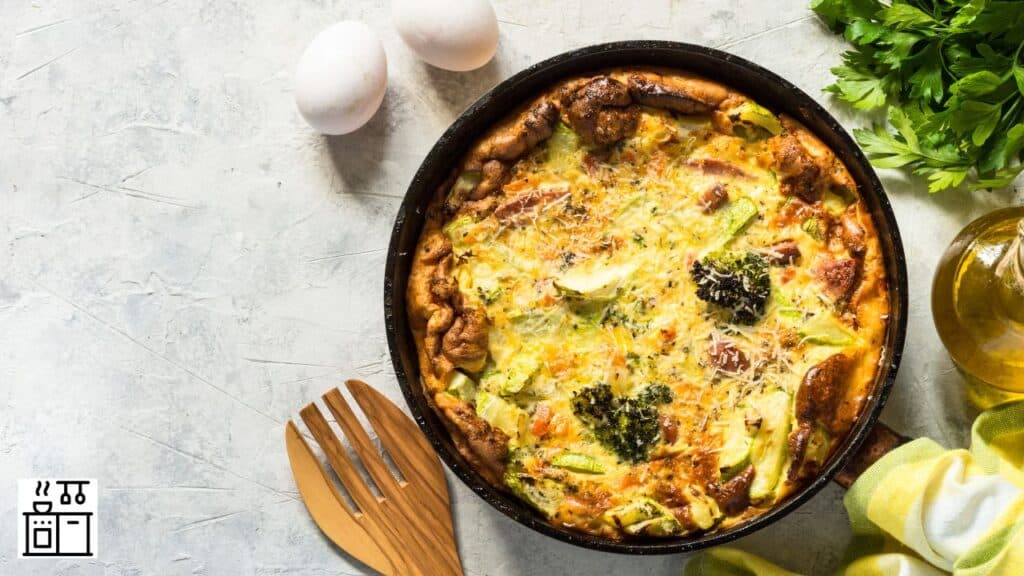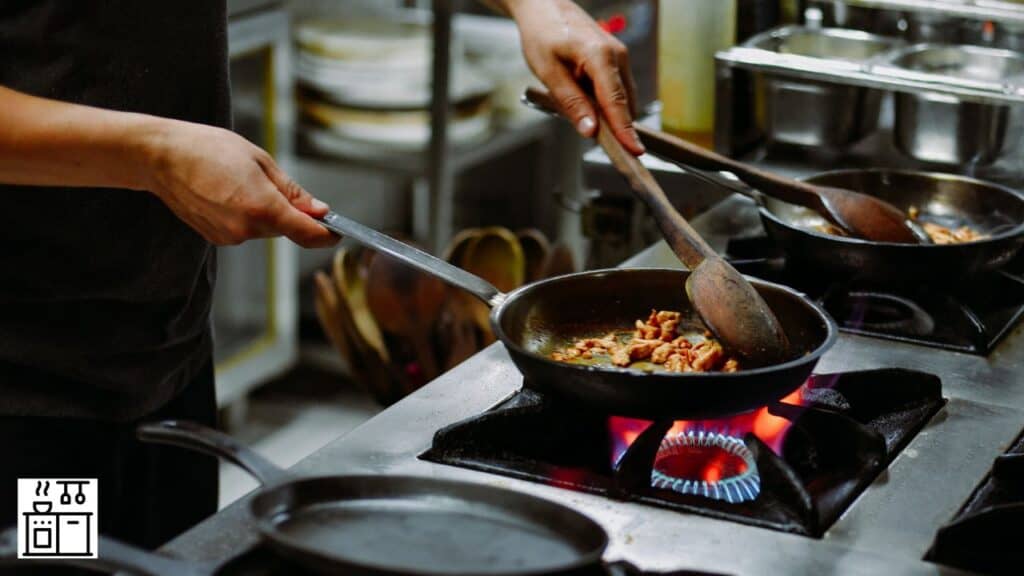Pans are cooking utensils with flat bases and raised edges for frying, baking, making stir-fries, and much more. They have been around for almost forever.
The modern-day pan is an adaptation of the Old English “panna,” which was made of cast iron with a flat base, a long handle, and three legs that raised it above the coals in a fire pit.
Over time, they have evolved in size and shape to satisfy specific needs.
So, let us look at the different types of pans and what to use them for.
Frying Pan
You will find at least one frying pan in any kitchen. They are very popular because of their versatility and ease of use.
These pans have a wide and flat base, with slightly flared high sides.
They are used for various purposes ranging from sautéing vegetables and making stir-fries to shallow or deep-frying vegetables and meat.
The term “frying pan” can be used to describe pans made of different types of metals with different dimensions.
Here are some of the common materials used to make them.
- Cast Iron: Cast iron pans are a traditional favorite because of their durability and natural non-stick properties. With continuous use, these pans develop a shiny black patina that is responsible for their non-stick properties. The heavy base heats slowly but evenly, creating a beautiful brown color on the surface of the food.
- Carbon Steel: Carbon steel is like cast iron but lighter and easier to handle. It’s naturally non-stick, and it cooks food thoroughly and evenly.
- Stainless Steel: Stainless steel pans are not naturally non-stick. However, they are lightweight, easy to handle, and dishwasher-friendly.
- Teflon: Teflon pans have a non-stick coating made of PTFE or PFOA that makes the surface non-stick. They are light and easy to handle. However, the surface is vulnerable to scratches and can erode quickly. They are usually not dishwasher-friendly.
- Ceramic: Ceramic pans have a silica layer that makes the surface non-stick. These pans look beautiful with a pristine white or grey base and iconic colors for the rest of the pan. They are lightweight, durable, and easy to manage.
Other materials used to construct pans are anodized aluminum, copper, and aluminum.
You can also find tri-ply and multi-ply heavy-duty metal frying pans.
Griddle Pan
Griddle pans are flat, heavy-bottom pans with shallow sides. They are wide and long and usually cover two burners on the stovetop.
The large surface area makes it possible to cook a variety of dishes in this pan. You can use it to make pancakes, burgers, bacon, fried eggs, and more.
Griddle pans are usually made of heavy metals like cast iron. But you can find non-stick versions too.
Roasting Pan
Roasting pans, as the name suggests, are used for roasting ingredients in the oven. They are widely used to cook poultry and meat.
These pans come in different shapes and can be made of different metals. They are rectangular and flat with raised edges.
You can find roasting pans that are deep enough to hold an entire Thanksgiving turkey or large meatloaf.
Saucepan
Saucepans have a flat base and high edges. The sides are higher than regular frying pans, sauté pans, and griddles. Hence it can hold liquids.
Saucepans are used to make stocks, sauces, and stews.
Deep saucepans are also suitable for making soups. These pans resemble stockpots but come with a long handle instead of handles on the side.
Saucepans make it easy to prepare sauces for pasta. You can also use them to prepare small portions of soup.
Skillet Pans

Skillets are a variation of a frying pan or a griddle. Their sides are higher than frying pans, and hence they hold more ingredients.
These pans can go directly on a fire. So, you can use them to cook on an open fire.
Skillets are usually made of cast iron or carbon steel. They are naturally non-stick, and hence they need less oil for cooking.
You can use them to fry, sear, sauté, or grill meat and vegetables. Skillets are typically used for shallow frying.
They are not great for cooking with liquids since they can only hold a limited amount of liquid.
Deep Skillet Pans
The size and dimensions of a deep skillet fall between that of a frying pan and a saucepan. It has high sides to hold more liquid.
So deep skillets are ideally suited for braising meat and cooking vegetables or fruits in liquid.
You can use them for preparing or simmering liquid-based dishes like curries and gravies, apart from using them for frying and sautéing.
Sauté Pan
A sauté pan looks like a frying pan, but it has straight and raised edges. The edges are not angled like a frying pan.
This is to prevent the liquid and oil in the pan from splattering.
These pans are also good for sauteing green vegetables like kale and spinach that reduce in size after cooking.
Sauté pans are good for poaching eggs, sauteing vegetables, and sauce reduction. They usually come with a lid.
So you can close the pan after adding the ingredients to let them steam.
Wok
A wok is a Chinese pan that is widely used in Asian cooking for tossing and mixing.
The pan has a very small circular base with high edges. It’s quite big and can hold a large quantity of ingredients.
The unique shape of the pan makes it easy to move the ingredients around quickly and toss them up and down.
Woks are the best types of pans to mix ingredients for fried rice and stir-fries.
Carbon steel is usually used to construct woks. However, there are woks made from non-stick and stainless steel too.
The walls are not too thick, so the sides heat up well and speed up the cooking process.
Traditionally, woks either have handles on either side or have a single long handle.
The ones with single long handles are easy to handle only when the pan size is small.
The bigger it becomes, the more difficult it is to lift and move with a single handle.
Paella Pans
A Paella pan is used in Mexican cooking to prepare paella, a rice dish mixed with vegetables and meat. These pans are wide and shallow.
The wide base allows the rice to spread out evenly and cook well. So, the rice absorbs the liquid properly and cooks evenly.
Paella pans are usually made of cast iron. The benefit of a cast iron pan is that it doesn’t burn the food easily. It also heats evenly and thoroughly.
But, lightweight paella pans are better suited because they are easier to handle.
You can toss and mix the ingredients better, and they also cool down faster.
Muffin and Cake Pan
These pans are used for baking. They are made of materials that can withstand high temperatures and can go in the oven.
Muffin pans usually have multiple wells in the base to hold individual muffins. Meanwhile, cake pans may have a fixed or detachable base.
They are usually light, and you will fill the batter midway to let the cakes or muffins rise within the pan.

